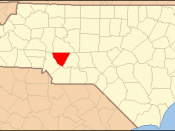Cyanide in Gold MiningAbstract:Without the use of cyanide in the gold mining industry, the worldÃÂs production of gold would not nearly be as high as it is right as the very moment. Gold is very important to many different cultures; its uses go far beyond its use in jewelry. Gold is needed for various forms of electronic equipment. CyanideÃÂs use has enabled the gold mines to have a higher output of gold, so therefore this very useful elementÃÂs demand has grown. CyanideÃÂs usage is also very controversial, due to its harmful effects on the environment and its toxic nature. But is it as harmful as many of us may think? The use of cyanide in the gold mining industry is growing everyday, thereÃÂs nothing we can do to stop its usage; the only thing that we can possible do is to be more careful with the ways that it is used.
Background:Gold mining is one of the most important industries in our country; providing the basis to which our countryÃÂs financial stability was founded upon. The first documented gold discovery was made in 1799, when John ReedÃÂs son, Conrad, found a 17 pound nugget in Meadow Creek. The ReedÃÂs farm was located in Cabarrus County, North Carolina. Gold mining is the techniques employed in the removal of gold from the earth. The techniques used in the finding of gold can be divided into two main types: manual and mechanical. Manual processes include panning, long toms, etc. The mechanical techniques consist of drilling, hydraulics, and many chemical processes; one being the use of the Cyanide Leach process.
Gold has been used since prehistoric times by humans; thought to be the first metal used by humans. This precious metal was valued for its ornamental value and ÃÂmagicalÃÂ properties. During the Middle Ages alchemists tried to transmute other metals into this valuable substance. ÃÂGold feverÃÂ struck Europe and many quests were made in the search of gold. This element has been used as coins, jewelry, and in many electrical devices. (Columbia University Press, 2005)Gold is very ductile and malleable; it is easily beaten into thin sheets of gold leaf. Gold is relatively chemically inactive, making it unaffected by moisture, oxygen, and many acids. Gold can be found in many locations around the world. The majority of the time gold is found in its metallic state, in the forms of dust, flakes, and nuggets. This metal is found in alluvial placers and in quartz veins. The main producers of gold are South Africa, the United States, Russia, Australia, and Canada. All of these countries employ the usage of the Cyanide process (Columbia University Press, 2005).
Cyanide is a poison that is very lethal to mostly anything living. It is also a very fast acting poison. If someone is given a sufficient dose, it could kill them in only a few minutes. Cyanide can be inhaled, ingested, or absorbed through the skin. Cyanide causes hypoxia in cell, meaning that the cells cannot use oxygen delivered to them. The respiratory system is not able to nourish the cells with oxygen. If the condition is not treated right away, the person will breathe rapidly, go into convulsions, go unconscious, and then suffocate. The most well-known antidote is amyl nitrate which can either be injected or swallowed.
Cyanidation was first discovered by Carl Wilhelm Scheele, who discovered Cyanide. The modern Cyanide Process was developed in 1887 by John Seward MacArthur and the brothers Dr. Robert and Dr. William Forrest in Glasgow, Scotland (Wikipeda, 2005). After this discovery, it was widely used in the mining of gold because of the great recovery rate; the gold recovery percentage soon jumped from 40%-50% to 85%-95%, doubling the worldÃÂs production of gold. Before, gold had only been mined through manual processes, but the fine grain gold and gold dust particles had been wasted, being thrown out in what is known as the mine tailings. With this discovery, it made it possible for low-grade ores to be mined without it being a financial risk (Nigel Bunce and Jim Hunt, 2005).
Cyanidation, also known as the MacArthur-Forrest Process, involves dissolving the precious metal in a Cyanide solution, either Sodium Cyanide or Calcium Cyanide. The chemical reaction used is called the Elsner Reaction; the Stoichiometry of the reaction is: 4Au + 8NaCN + O2 + 2H2O â 4NaAu(CN)2 + 4NaOH (Wikipedia, 2005).
Methods:The MacArthur-Forrest process or Cyanidation, is a metallurgical method used to separate Gold and other metals from its ore ( See Appendix F for diagram showing entire process). Today this is the most used technique in the world the processing of gold, but due to CyanideÃÂs highly toxic nature the process is very controversial (Wikipedia, 2005). The two methods of Cyanidation used are Vat Leaching and Heap Leaching. Vat Leaching is used when twenty grams or more of gold are present within a ton of the ore. Heap Leaching is employed by the mining company for the low-grade ores.
First of all, a location that is believed to contain gold is first assayed for the content of the element. If the location is found to not contain enough of the metal, then the mining company does not see it profitable to mine that area. After determining the content the company will then mine the ore. Once the ore has been mined, the ore is then finely ground in a large-revolving cylinder containing large steel balls. If the ore contains impurities it can either be roasted or sent through a flotation process, which will concentrate the ore even further. If the gold particles are too large, the dissolution of the gold would take too long, so therefore the larger gold particles are taken out through the flotation process. Once the mineral has been sent through either of these processes, Lime (Calcium Hydroxide) or Soda (Sodium Hydroxide) is added to ensure during cyanidation that the pH is over 10.5 (Wikipedia, 2005). Even though the kinetics of the reaction are slowed by the raising of the pH(See Appendix A), it must be done to avoid the production of toxic Hydrogen Cyanide gas (CN- + H+ = HCN (g)) (Wikipedia, 2005).
Now the ore is ready to be combined with either Sodium Cyanide or Calcium Cyanide. Depending on the percentage or gold in the ore, it will either undergo Vat or Heap Leaching. In Vat leaching the ground ore is mixed with the Cyanide Solution in large metal vats. Low-grade ores are used in the Heap Leach process, where the ore is placed on top of an impermeable membrane and the solution is applied with sprinklers or an irrigation system. The leaching can take several days or weeks to ensure that the most of the gold has been dissolved in the solution (International Cyanide Code, 2005). Oxygen must be bubbled up through the pulp in order for the dissolution of the gold to occur. The Cyanide anions release the goldÃÂs cations, oxidizing the gold and making a soluble aurocyanide metallic complex, NaAu(CN)2 (Wikipedia, 2005). The resulting gold cyanide complex is very stable. The solution is allowed to percolate through the heaps. The leach slurry trickles to the bottom, collecting on the impermeable membrane, where it is channeled to reservoirs (International Cyanide Code, 2005).
The gold in the solution can be recovered by zinc cementation (using the Merrill-Crowe Process), Carbon in Pulp (CIP), Electrowinning, or the Resin in Pulp process (Wikipedia, 2005). The most widely-used process is the Carbon in Pulp Process because of its cost-effectiveness. The activated carbon is introduced into the solution, where it traps the gold on it. The carbon adsorbs the gold relatively quickly (8-24 hours) (International Cyanide Code, 2005). Elution is the method by which the gold is then recovered from the activated carbon, usually with a hot caustic aqueous cyanide solution. Afterwards, zinc cementation or electrowinning is employed to retrieve all of the gold. If the gold contains too many base metals (See Appendix B) it is taken directly into smelting to be purified to either 99.99% or 99.999% (International Cyanide Code, 2005).
Results:As of today, there are four forms of Cyanide Solution treatment and reuse. These consist of natural degradation (See Appendix C and D), chemical oxidation, Precipitation, and biodegradation. Sometimes it is possible for the mining companies to recycle their cyanide solution after they have retrieved the gold.
In the precipitation process, certain complexing agents can be added to make stable cyanide complexes. This keeps the concentrations of free cyanide to a minimum. When iron is added to the cyanide solution, it forms an insoluble cyanide salt that traps the cyanide (Mark J. Logsdon, Karen Hagelstein, Terry I. Mudden, 2005).
Biodegradation takes place when anaerobic and aerobic micro-organisms are used to break down the cyanide into less toxic complexes. Usually the cyanide complex is sent through reaction vessels containing bacteria. The bacteria use oxygen to decompose the cyanide into more natural complexes such as: nitrates, bicarbonates, and sulfates (Mark J. Logsdon, Karen Hagelstein, Terry I. Mudden, 2005).
What happens when this lethal commodity is released on the environment around it? In February of 2000, the detrimental effects were soon known. Toxic cyanide leaked from a gold mine in Baia Mare, Northern Romania. When an unexpected heavy snowfall flooded a dam containing cyanide-water solution to leak and break. The resulting leak proceeded to let out over 130,000 cubic meters of water tainted with cyanide. The water made its way into the Lupes, Somes, Tisza, and Danube rivers. This killed thousands of fish, birds, and other species of animals. The effects of the pollution were felt throughout three countries and it polluted over 400 kilometers of waterways (See Appendix E) (Christina Nicholas, 2005).
The Romanian incident has become the most infamous because of it was on such a large scale. There have also been other spillages in the United States and in Australia.
Conclusion:Cyanide is a deadly chemical complex that is used often in the mining industry. It is best that everyone know what the effects are of the process. People of the world should also be aware that cyanide is not harmful unless it is used incorrectly or a freak accident occurs in which it leaks out into the environment. Mining plants now have the capability to recycle their cyanide. There have been strict explicit regulations placed on the use of cyanide to limit the exposure to humans and the environment. There are four risk management scenarios that should addressed according to the mining site:ÃÂÃÂ Exposure of humans or ecological receptors to cyanide spilled during a transportationaccident.
ÃÂ Exposure of workers, particularly to HCN gas in enclosed areas.
ÃÂ Exposure of humans through releases of cyanide in solution to surface or groundwater that may be ingested.
ÃÂ Exposure of ecological receptors, such as birds or fish, to cyanide-bearing solutions (Mark J. Logsdon, Karen Hagelstein, Terry I. Mudden, 2005).ÃÂWithout Cyanidation we wouldnÃÂt have numerous electronic equipment, nor would we have the gorgeous jewelry that many women enjoy wearing. In oneÃÂs opinion, there are certain risks with the process, but arenÃÂt there risks in everything anyone does. Some things are necessary for the human population to continue its progress.
References:Bryson, Herman J. (1936). Gold deposits in North Carolina. Raleigh: (n.p.)Bureau of Mines. (1982). Improvements in heap leaching to recover silver and gold fromlow-grade resources [Report of Investigations]. Washington, DC: U.S. Government Printing officeColumbia University press. (2003). Gold, compounds, and elements. Retrieved July 13,2005, from http://reference.allrefer.com/encyclopedia/G/gold.htmlCyanide Management Code. (n.d.) Use of cyanide in the gold industry. RetrievedJuly13, 2005, from http://cyanidecode.org/library/cn_facts_use.htmlHagelstein, Karen, Logsdon, Mark, Mudden, Terry. (n.d.) The management of cyanide ingold extraction. Retrieved July 14, 2005, from http://www.cyantists.com/ICMMCyanide%20Mgmt.pdfLaney, Frances Ph.D. (1910). The gold hill mining district of North Carolina. Raleigh:Edwards &Broughton Printing Co.
Mineral Policy Center. (n.d.) MPC fact sheet: cyanide. Retrieved July 13, 2005, fromwww.earthworksaction.org/pubs/CyanideFactSheet.pdfNicholas, Christina. (2004). Dirty gold: The toxic legacy of cyanide leach mining.
Retrieved July 13, 2005, from http://journalism.uts.edu.au/miningoz_2004/DirtyGoldWikipedia. (n.d.) Cyanide process. Retrieved July 13, 2005, fromhttp://www.answers.com/topic/cyanide-process





